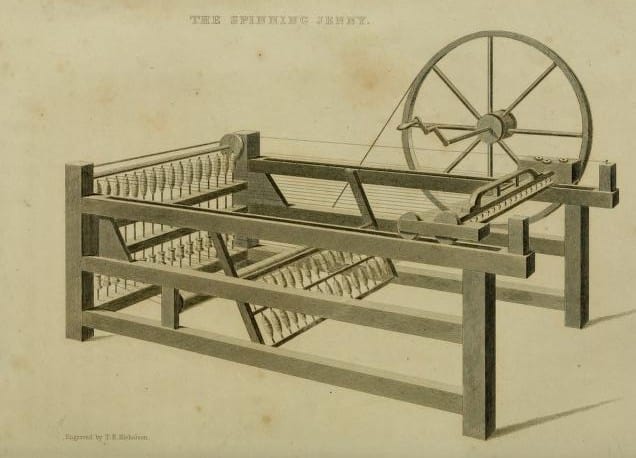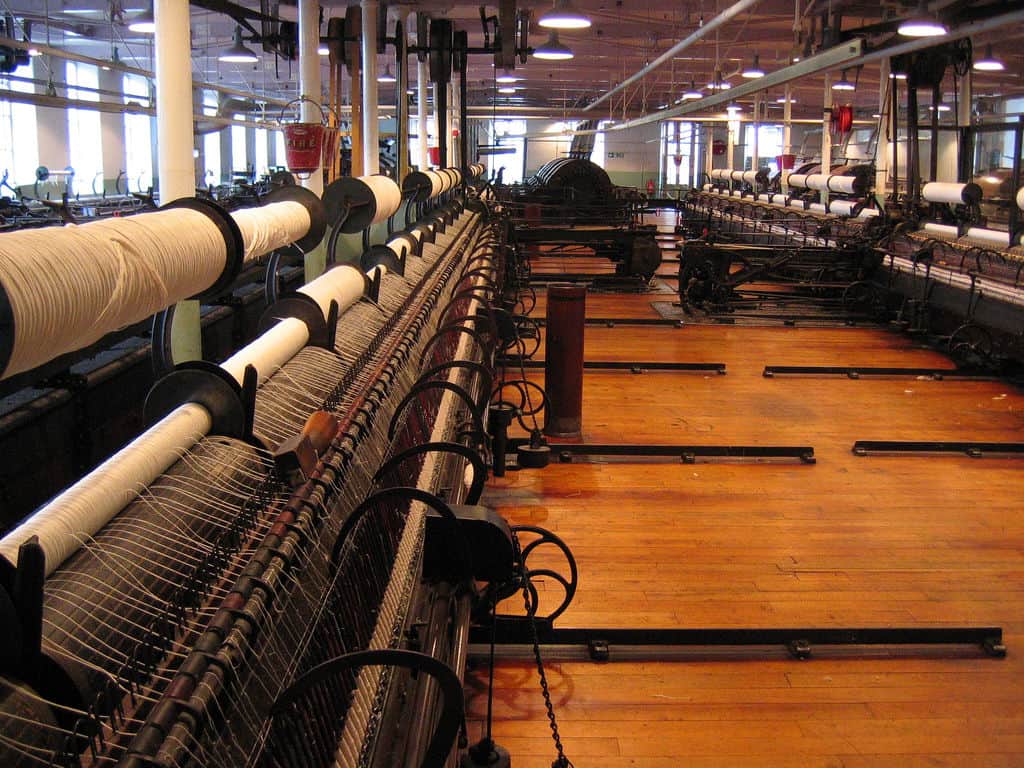Easy to Draw a Spinning Jenny Spindle
Let's know more about the Spinning Jenny!
- In 1770, James Hargreaves invented a machine that was about to forever change the destiny of the textile industry within Europe, and subsequently America in 1820. The Spinning Jenny took cotton out of the home and into the workshops, therefore no longer keeping it a cottage industry.
- James Hargreaves was born in January, 1721 in Oswaldtwistle (Lancashire) and died on April 22, 1778 in Nottingham. Not much is known in regards to his early years of life. However, he had a wife called Elizabeth with which he had eleven children, and his origins were humble.

Historical background of the Industrial Revolution
- Often called as the First Industrial Revolution, this revolution began in Britain between 1760 and 1840. Invention and innovation in technologies led to higher productivity and urbanisation in Britain which easily spread in Europe and the United States.
Causes of the Industrial Revolution
- Political and colonial wars in Europe
- In the mid-18th century, many European nations emerged as colonial powers. By this century, the British Empire had vast territories across the globe. Moreover, major wars, including the Seven Years' War, American War of Independence, and the Napoleonic Wars engaged Britain to look for innovations and pressure of production.
- Scientific Revolution
- The emergence of scientific knowledge which questioned the established tradition of the church gradually opened liberal thoughts and scientific inventions and discoveries of people like Galileo Galilei, Rene Descartes, and Isaac Newton.
- Agricultural Revolution in Britain
- Between the mid 17th and 19th century, agricultural production in Britain increased due to intensive farming methods, including crop rotation, enclosed fields, selective breeding, and heavy manuring.
- Population growth
- In effect of sufficient agricultural production, the population in Britain increased quickly throughout the 18th century. As a result, they had enough labour to sustain industrial growth.
- Supply of coal and iron
- Great reserves of coal and iron were Britain's largest advantage. The invention of the coal powered steam engine led to improvements in technique of coal mining, thus making them the largest iron industry in the world.
Invention of the Spinning Jenny!
- James Hargreaves lived in a city that, before the Industrial Revolution, was one of the 'major textile centres'. In fact, most of its inhabitants were employed within the textile sector, and 'entire families were involved, men were often the weavers while children assisted in cleaning raw materials and women spun the materials into threads or yarns'. As a consequence of the huge involvement and process behind weaving, it was difficult to meet the merchant's 'demands for textile goods' (which in turn, caused a massive 'gap between supply and demand') .
- Hargreaves' thought of creating a spinning machine came about in an absolutely casual manner.

- In fact, it happened when his daughter 'accidentally overturned' the spinning machine: he observed how the spindle kept revolving 'in an upright rather than horizontal position', and therefore, he came up with the idea of spinning 'several threads at one time'.
- Hargreaves worked for three years on his new machine in order to perfect it. In fact, the first spinning jennies that were created produced a thread that was much thinner compared to the one made by hand with the drop spindle.
- The first spinning jenny built by Hargreaves in 1764 used eight spindles which were directly connected to the thread and set of rovings. The eight threads were then spun at once using a single wheel. Amidst his success, he only applied for a patent in 1770 which caused his idea to be copied by others. By the time of his death in 1778, about 20,000 spinning jennies were being used in Britain.
- Unlike wool, cotton was much more difficult to spin since it has a short staple length. Cotton had been spun for thousands of years with a drop spindle which is characterised by a string with a weight at the bottom of it: the fibres are placed on top of the string, and once the string is gently twisted, the fibres are locked together.
- The Spinning Jenny worked on the same principles as the drop spindle. However, it was vertical, and one one side it presented a row of spindles, whereas the opposite side had a row of pins. Allen (2007) describes in great detail and accuracy how Jenny worked: 'The rovings were wound on these pins, and each roving extended across the jenny to the opposite spindle. The spindles were spun by belts from a single wheel. Between the spindles and the pins was a sliding bar with clamps that could grasp the rovings and draw them out. Twist was then imparted by turning the spindles, and finally, the yarn was wound onto the spindles as the sliding bar was pushed towards them. At the same time, the sliding bar pulled out more roving, and the sequence was repeated'.
- In essence, Jenny 'mimicked the actions of a spinster and wheel but on an expanded scale'. Moreover, sources claim that whereas in the 1750s Britain imported only 3 million pounds of raw cotton, in 1786, more than 18 million pounds of this material were introduced in the country.
Opposition to the Spinning Wheel
- Before the invention of Jenny, the spinning of wool would take up an incredibly long amount of time. When the machine was first introduced, it caused much upheaval amongst the part of the worker's part of the population.
- Hargreaves started selling the machines to the local population, however, 'since each machine was capable of doing the work of wight people, other spinners became angry about the competition'.
- As a consequence, machines were destroyed with the intention of hindering the replacement of workers with machines. Unemployment was very much feared, and therefore, on one occasion, hand spinners broke into Hargreaves' home and destroyed his machines. As a consequence, the inventor moved to Nottingham in 1768 in order to provide for his family in a more stable environment. Two years later after building his own mill, Hargreaves applied for the patent.
After the invention
- Following the invention of the spinning jenny, the succeeding events happened in Europe:
- Textile factories started to be built everywhere across Europe, and as a consequence, workers had to move from the countrysides to the cities, where they were forced to live and work in inhumane conditions.
- However, over 80% of the population worked in the countryside, and 'many were malnourished, with an average life expectancy of 28 years' .
- In fact, during the industrial revolution, the factory workers worked in appalling conditions and did not have any rights or insurances: normally, they would work between 12-14 hours; male workers were paid 15 shillings per week (75p), whereas women with children were paid 3 shillings (15p); punishments would be frequent if work was not carried out properly; the loud machines would damage the workers' hearing.
- Moreover, their living conditions were not any better. For instance, since the majority of the countrysides' population was moving out into the city, these were crowded and there were not enough houses for everyone.
- Therefore, people would live in slums or in other overcrowded zones where it was easy to get diseases such as typhus, tuberculosis, and cholera; human waste was not disposed adequately and the water that people drank was polluted with human waste.
- The main transformation that Spinning Jenny (as well as other machines) brought was the introduction of mass production.
- In summary, the spinning jenny was able to do at once the work that eight people could have done only together. This is the reason why Hargreaves' invention was considered particularly dangerous for the hand-spinning workers. The invention gave rise to a new era of industrialisation. In addition to efficiency, the machine enabled larger quantities of production while employing fewer workers.

Image sources:
[1.] https://upload.wikimedia.org/wikipedia/commons/0/04/Zeichnung_Spinning_jenny.jpg
[2.] https://upload.wikimedia.org/wikipedia/commons/thumb/1/14/James_Hargreaves.jpg/490px-James_Hargreaves.jpg
[3.] https://c1.staticflickr.com/1/12/16276040_35e250f084_b.jpg
gonzalezsheithers.blogspot.com
Source: https://schoolhistory.co.uk/industrial/industrial-revolution/spinning-jenny/
Post a Comment for "Easy to Draw a Spinning Jenny Spindle"